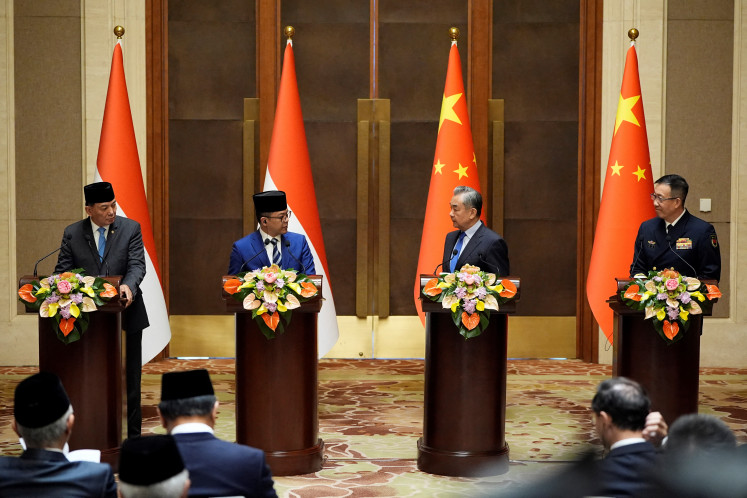Revisiting Raden Saleh’s Arrest of Prince Diponegoro
Raden Saleh’s Arrest of Prince Diponegoro (JP/P
Change text size
Gift Premium Articles
to Anyone

Raden Saleh’s Arrest of Prince Diponegoro (JP/P.J. Leo)
Of the 29 State Palace paintings recently exhibited at the National Gallery as part of Indonesia’s 71st Independence Day celebrations this year, the Arrest of Prince Diponegoro by painting great Raden Saleh remains the most complex symbolism of the early struggle for independence in Java.
Saleh, a Javanese nobleman who studied painting in The Hague, the Netherlands, spent most of his time in Dresden and Coburg, Germany and Paris as a European royal court painter, created the painting in 1857 by adopting the romantic style prevailing in Europe at that time without witnessing the actual event.
Covertly expressing Saleh’s personal voice and emotion, the painting depicts an enraged, defiant Diponegoro with his clenched left fist upon realizing that the invitation of Dutch supreme commander Gen. Hendrik Merkus De Kock, pictured standing next to him, to negotiate on equal terms, was a ploy to capture him.
Diponegoro was the eldest son of Yogyakarta ruler Sultan Hamengkubuwono III. Widely regarded among the Javanese as Ratu Adil (Javanese messiah-like just King), he started a holy war against the Dutch colonialists known as the Java War, which occurred between 1825 and 1830.
Apparently, Saleh wanted to show that despite the defeat, Diponegoro remained a never-say-die, unyielding fighter in order to rebut an earlier colonial painting titled The Submission of Prince Dipo Negoro to General De Kock by Dutch painter Nicolaas Pieneman. Pieneman’s painting makes Diponegoro look like “a criminal who inspires contempt” as described in governor-Gen. Johannes van den Bosch’s letter to De Kock.
Saleh’s portrayal, clearly meant to immortalize Diponegoro’s dignity, bravery and heroism, is also meant to save Diponegoro’s face and the face of Javanese people, his included. Javanese is a high context culture where saving face is very important.
The face-saving thread continues in De Kock’s solemn, good-hearted-looking face seen in Saleh’s painting. De Kock looks into the distance as if not daring to look him in the eye, which reduces him to a mere greeter who, with his outstretched open hand, politely and respectfully ushers the prince to a waiting coach that will take him into exile, as befits a king.
Then comes the insinuation. Although De Kock in Saleh’s painting doesn’t look arrogant like in Pieneman’s, his arrogance is hinted at his slightly bigger head disproportional to his body, subtly suggesting an ogre eating up Diponegoro’s aspiration to establish a Muslim caliphate state.
Saleh’s rendition of De Kock in a mannequin-like, spiritless, frozen, almost two-dimensional like state may be his way of hideously saying that the leading man in his painting is Diponegoro, not De Kock, although the latter is shown in full view with a Dutch Maltese cross on his chest signifying the highest royal orders of merit to make the Dutch viewer think that the victorious general is the star of his painting.
Such reverse symbolism was apparently necessary to avoid offending the Dutch government, which paid for Saleh’s education in Europe for nearly 23 years.
Although historical accounts record no women in Diponegoro’s entourage at the time of his capture, Saleh introduced a distraught woman at Diponegoro’s feet — perhaps inspired by paintings of women at the foot of the cross during Jesus Christ’ darkest hours he might have seen in Europe.
Perhaps she symbolizes the motherland grieving Diponegoro’s defeat or the evil inherent in women as hinted in classic Javanese literature (Ślokāntara, Panitisastra, Centhini) that lead great men to misery or downfall, which, in Diponegoro’s case, was imbued with racist overtones.
Diponegoro in his autobiographical chronicle ascribed his disastrous defeat in the battle at Gowok outside Surakarta (now Central Java) in 1826 to his dalliance with a captured Chinese girl whom he employed as a masseuse the night before. Instead of finding out the root cause of his defeat and fixing it, he irrationally and ungentlemanly forbade his followers to marry Chinese women whom he regarded as the culprit behind his and his brother-in-law Sastradilaga’s defeats.
By doing so, he further inflamed the anti-Chinese sentiment already ablaze at around the start of the Java War with the massacre of the Chinese community in Ngawi on Sept. 17, 1825.
Was Saleh aware thereof? Maybe, but this was obviously not his concern.
For him, what really mattered was Diponegoro’s arrest and its consequences for the future of his beloved Javanese heartland, so much so that he found it imperative to insert his three selves (mind, intellect and ego) among Diponegoro’s followers in the painting to identify himself with him and accentuate the totality of his engagement.
First, Saleh appears as Diponegoro’s fan solemnly bowing his head to pay homage to him. Second, he appears as a critical assessor of the episode with his mouth slightly open, his hand on the chin, looking somewhat disdainfully at the ungentlemanly tactics of feigned friendship and seeming accommodation that De Kock, a freemason like himself, used to trap Diponegoro. Lastly, Saleh appears as a pensive onlooker with arms crossed, left hand partially hidden, perhaps to repress his anger and keep himself still as if subtly signaling masonic hidden hand message of “this is what I’m part of, what I believe in and what I’m working for because what I am is what I ultimately do.”
Saleh had ultimately done what his conscience urged him to.









